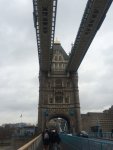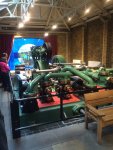
Tower Bridge
Londres, le jeudi 19 février 2015
In the 19th century, the city of London is sorely lacking means to cross the river. Several solutions are proposed so as to set up a system of shuttles which makes the connection between two banks but this idea is very fast abandoned. The city decides then to throw a big competition to build abridge answering a very precise criterion : crossing the river without hampering (bothering) the commercial traffic. Thus, the main criterion is to enable the boats to pass, whether they are tall or small, wide or fine. Loans of fifty projects are then submitted in discussion and it is finally Horace Jones’ work which will be kept. Today, the bridge(deck) is a monument in which streams every day hundreds of visitors. Such a building cannot be neglected. Its utility of the former days is still what makes it an impressive construction. The exhibition which is dedicated to it is a token of its importance
In 1886, an application for a bridge project was announced.
It is in 1884, that the proposal of the architects Sir Horace Jones, an English architect and George D. Stephenson, a civil engineer, inventor and mechanical engineer who built the first public inter-city railway line in the world to use steam locomotives, the Liverpool and Manchester railway and John Wolf Barry another engineer, was chosen. Tower Bridge required eight years ofconstruction. Sir Horace Jones died in 1887, before the end of the construction of the bridge in 1894.
Tower Bridge in London measures 286m to cross the Tamise which measure 272m at this point. The width of this bridge is 15m and the two mains towers are 43m high. Between these two towers there is 61m long of the drawbridges. The drawbridges can up to 86° to let the way for the higher ships. This bridge was built with stone, steel and granite. The final weight is in the order of 11 000 tons.
This bridge has a special mechanism created by an engineer, later improved in 1974. The original raising mechanism was powered by pressurised water stored in several hydraulic accumulators (reservoirs). The system was designed and installed by Hamilton Owen Rende. A hydraulic accumulator is a reservoir in which the pression can be higher for a few moments. Water, at a pressure of 750 psi (5.2 MPa), is pumped into the accumulators by two 360 hp (270 kW).
This system uses pistons.
They secured the bridge during the Second World War because of the bombs. It’s this hydraulic system which was improved in 1974 : they added electricity. This hydraulic system activates two counterweights which lift both sides of the bridge for the ships to pass. Each bascule weighs 1200 tons including one counterweight of 410 tons !
The fish in the Thames :
The Thames passes by London and it stops to the (Mer du nord).
The rate of salt in water is depending on the tide. Some fish lived into this river : like seahorse !
- Podcast et RSS
- Plan
- Mentions
- Rédaction
- Se connecter

-
2009-2024 © Lycée George-Sand La Châtre - Tous droits réservés
Ce site est géré sous SPIP 3.2.19 et utilise le squelette EVA-Web 4.2

Dernière mise à jour : lundi 24 janvier 2022







